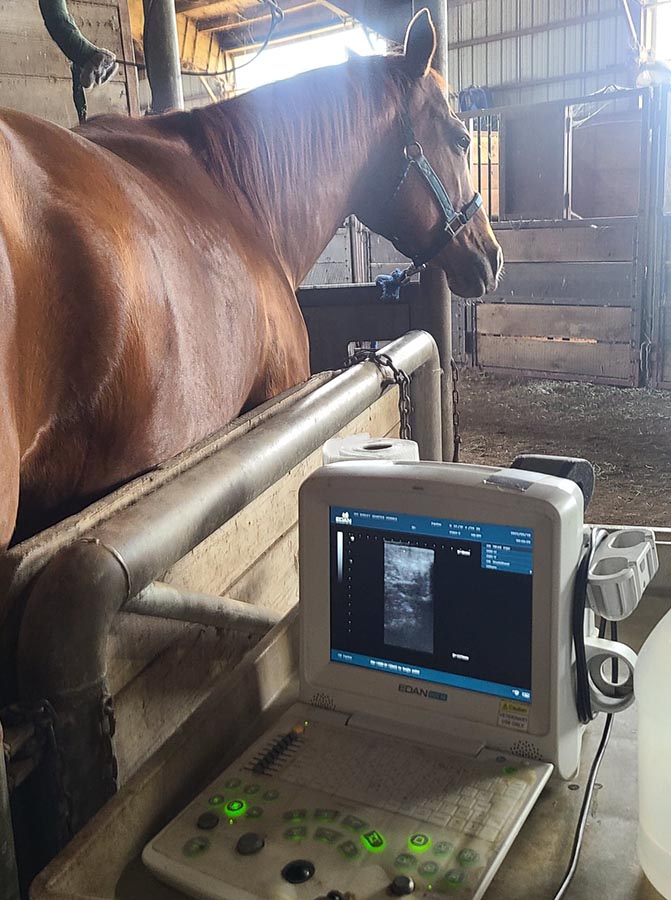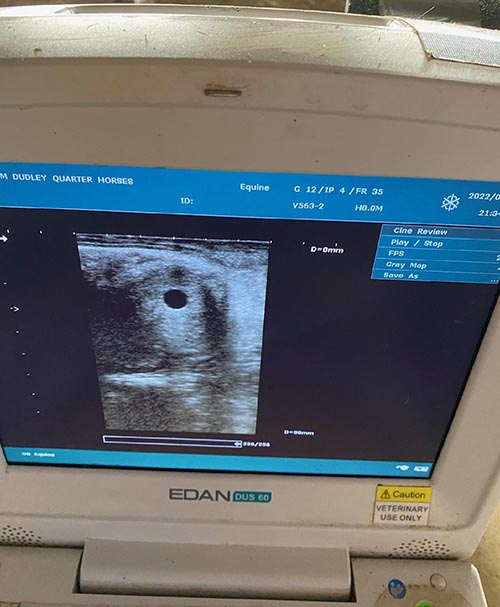
When my mother and I first decided to breed Sky, we were aware that it could be a long process. However, the allure of a quality foal from one of my favorite mares was enough to persuade us to take the plunge. When we first began the process, we carefully evaluated her conformation and temperament to determine if she was a proper breeding candidate, you can read more about that in my initial blog post, Breeding Chronicles Part I: Considerations When Deciding to Breed My Mare.
After we determined that she was of breeding quality, we began looking at stallions to evaluate which one would be the best match for Sky. We considered a variety of different factors, including pedigree and performance records to finally settle on breeding Sky to Dual Reyish, a double-registered APHA/AQHA Stallion. You can learn more about the selection process and how we chose this stallion on my blog, Breeding Chronicles Part II: Selecting a Stallion.
Once we selected the stallion and signed all of the breeding contracts, the process of breeding Sky began. It was quite a long undertaking, with us beginning to track her cycle in March (as soon as we had selected a stallion). When my veterinarian checked her, he noted that she had a large follicle, which is a positive sign, but her cervix and uterus had minimal tone. The “tone” of the uterus refers to estrogen levels and how close she is to ovulation. During a routine breeding check, your veterinarian will rank the uterine tone (poor, fair, good, excellent) during an ultrasound exam to help determine where they are in the heat cycle and the likelihood of conception. Because her uterus lacked tone, my veterinarian, Dr. Sawyer Shattuck, of Shattuck Veterinary Service, determined that Sky was in a “transitional heat.”
When a mare is in a transitional heat, the ovaries are becoming more active and they are preparing to ovulate again after a period of anestrus (not being in heat), over the winter months. Getting your mare in foal during transitional heat cycles is not possible.
We waited a few more weeks before rechecking her and seeing where she was in her cycle. It was clear at this point that she was cycling more regularly than before, which was good news. Sky had a good uterine tone, but she had two breeding-sized follicles that were developing. A follicle is a sac produced in the ovary that contains the egg. During ultrasounds Dr. Shuttack is also looking for a Corpus Luteum, often referred to as a CL, which is a hormone-producing structure that develops in the ovaries after ovulation and helps to regulate the progesterone levels (a hormone that supports pregnancy). Because it was early in the season, we chose to wait for another estrus cycle because we did not want to chance both follicles ovulating at the same time and Sky could become pregnant with twins. When horses have twins, it is extremely risky, with the foals rarely coming through the pregnancy successfully. It is very rare for both or either to survive.

Finally, during her next estrus cycle, we determined that she was ready to breed. For this cycle, we bred her with frozen semen. This is convenient because you can have frozen semen on hand prior to a follicle developing, provided you keep it properly frozen in a liquid nitrogen tank until you are ready to use it. Typically, frozen semen is stored in tubes, often referred to as straws. Typically, eight straws make up one breeding dose. After we had acquired the frozen semen, Dr. Shattuck began ultrasounding Sky to prepare her for insemination. During the ultrasounds he was checking Sky’s follicle size and uterine tone. A mare has thousands of follicles but during an estrous cycle, one dominant follicle develops. This is the follicle Dr. Shattuck began to track for breeding. His first measurement on the follicle was noted at 29 mm. The follicle’s diameter is measured by averaging the widest and narrowest parts visible on the ultrasound. A follicle can grow 3-5 mm a day. It’s important to note that each mare’s follicle maturity size and when they ovulate varies from horse to horse. Different breeds also have different averages and Sky had proven to be anything but average. He is looking for a breeding-sized follicle typically 32-38 mm for Quarter Horses or a “light breed”. He ultrasounded Sky two days later and noted the follicle had grown to a 32mm with better uterine tone. We knew that she was close to ovulation, so Sky was staying at the clinic for close observation. Dr. Shattuck ultrasounded her every four hours (yes, he was instrumental in the process, and he even checked her overnight!) this time looking for ovulation. Checking for ovulation so often is vital with frozen semen because the semen is not viable in the uterus for very long. There is a 6-hour window. With Dr. Shattuck checking every four hours, we were guaranteed not to miss her ovulation.
When Dr. Shattuck saw that Sky ovulated, it was time to breed her. To prepare the frozen semen, he thawed the straw of semen at 37 degrees Celsius (98.6 degrees Fahrenheit) water for 30 seconds. After the semen was thawed, my veterinarian bred Sky utilizing Artificial Insemination (AI), depositing the thawed semen into the uterine horn. You can learn more about the AI process in this article from Kentucky Equine Research, Artificial Insemination in Horses.
Just 12 hours after we bred Sky, fluid was detected in her uterus during a routine ultrasound. This was an autoimmune response to the foreign bodies (sperm) which has been introduced to her uterus, it is often known as post-mating induced endometritis. This is inflammation that could potentially flush the embryo from the uterus, so it is important to work quickly. Dr. Shattuck gave her a dose of Oxytocin to encourage her body to remove the rest of the fluid. Oxytocin therapy is often used for treatment because it is ecbolic, which means it encourages the uterus to contract to dispel excess fluids. In extreme cases, veterinarians can also drain the fluid via uterine lavage to make the uterus a habitable environment.
Fourteen days after the initial breeding, we checked to see if she was pregnant. Unfortunately, we discovered that she was not in foal. However, she had a large follicle measuring at 36 mm, which meant that it was time to order semen so that we could rebreed her, hopefully before ovulation.
This time, we were fortunate that the stallion owners were able to ship us fresh cooled semen. Fresh cooled semen tends to stay viable slightly longer in the mare than frozen semen, making it more likely that an egg will be fertilized. According to Patrick M. McCue DVM, Ph.D., of Colorado State University, “In general, pregnancy rates per cycle using frozen semen are 5 to 10% lower than with cooled-transported semen.” Dr. Shattuck checked the semen quality prior to breeding, this let us know the motility of the sperm as well as sperm count. By knowing that the sperm was high quality before breeding, we were able to rule out problems with the semen if Sky did not take on this round.
Fresh semen was overnighted, and Sky was given a shot of Deslorelin. When a follicle size is between 30-40 mm in diameter Deslorelin can be administered to trick the mare’s body into ovulation. Fresh semen is administered upon arrival regardless if the mare ovulated. The lifespan of fresh semen is significantly longer than frozen and can last up to 72 hours.
A routine ultrasound was performed to check for fluid (knowing her history) and to see if she had ovulated. Similar to the first time we bred Sky, she had fluid and was still holding tight to her follicle. Sawyer administered a shot of Oxytocin to help clear up the fluid. Another ultrasound was performed the following day to check for ovulation and if the fluid had cleared up. Finally, we had good news! The fluid was clearing up and there was a CL on her right side (the side she ovulated from). Next, we had to wait.

The wait felt like forever. I was less than hopeful given her holding onto the follicle even with Deslorelin and using fresh semen. But much to my surprise, during this breeding cycle we were able to confirm that Sky was in foal! We checked her at 14 days, and there was an embryo. Then, at 28 days we performed a heartbeat check. It was so thrilling to see that there was a heartbeat—it was clear that my dream foal may in fact become a reality!
Breeding Sky was a process that certainly had its ups and downs. It is important to realize that you can have everything perfectly planned, and sometimes there are some setbacks… but it is still worth moving forward with your plan. Just when we were starting to give up, Sky conceived her foal!
I am so excited that Sky is pregnant and we are one step closer to meeting the foal of my dreams. The breeding process was a frustrating experience at times, but I certainly learned a lot about my mare’s reproductive cycle with each attempt. Thank you for following along with my journey, I am excited to report back with Sky’s progress throughout the pregnancy. Be sure to check back to read my next blog installment on caring for Sky while she is pregnant and the prenatal veterinary care she receives.
